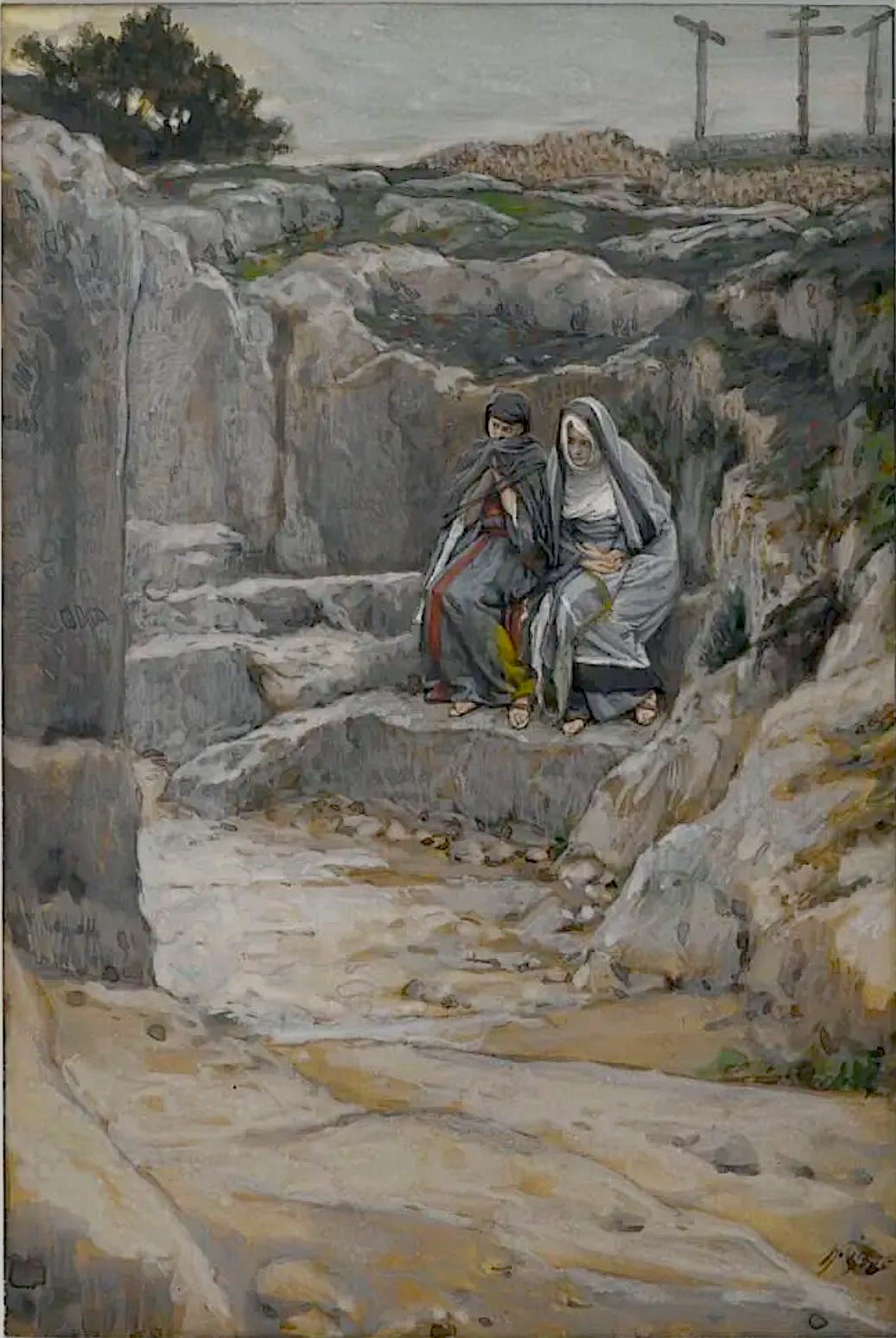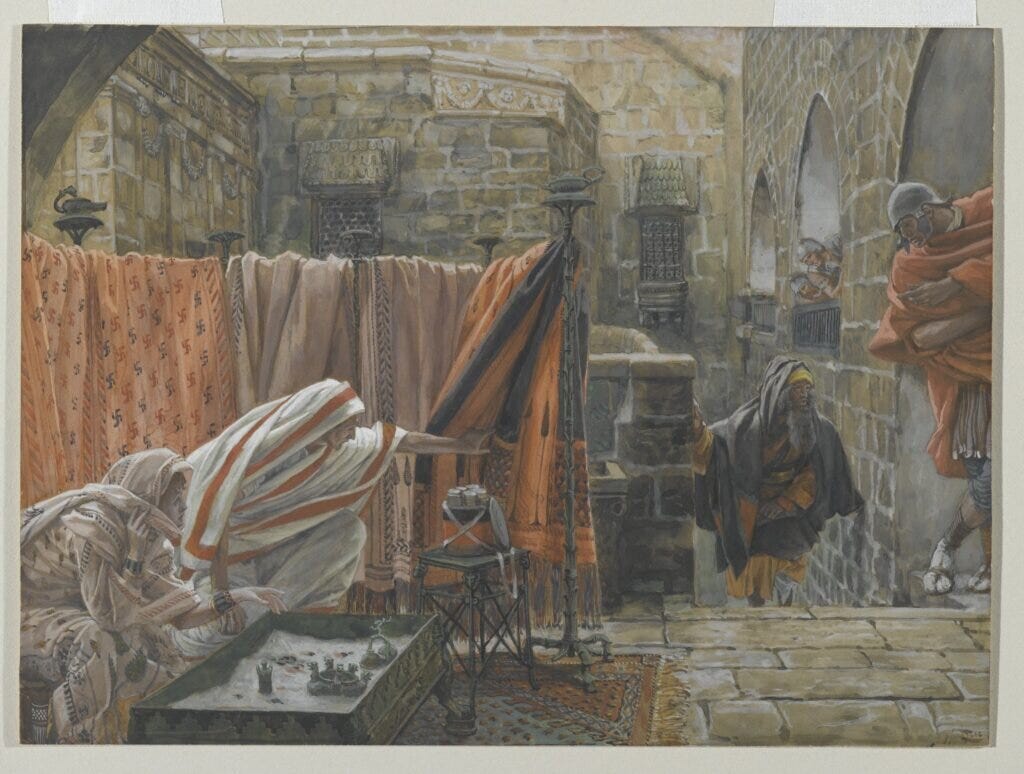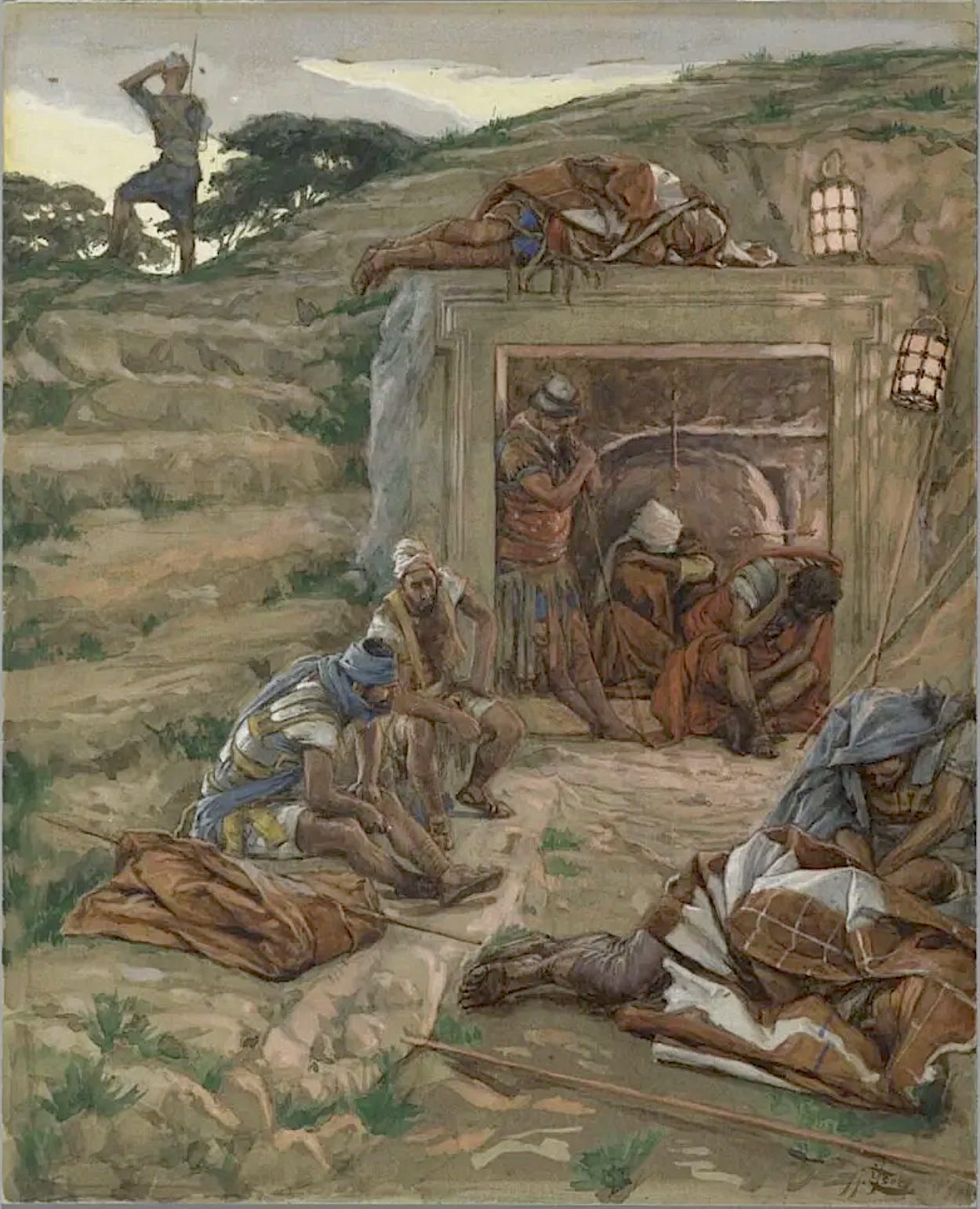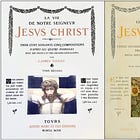Holy Saturday, Great and Holy Saturday, the Great Sabbath, Hallelujah Saturday, Saturday of the Glory, Black Saturday, Easter Eve, Joyous Saturday, the Saturday of Light, or Mega Sabbatun
By James Tissot and Dom Guéranger
Note: This series was originally posted at Dappled Things Deep Down Things blog and has been edited. Today’s post includes new illustrations and additional commentary from James Tissot.
Three Illustrations for Holy Saturday
+ The Two Marys Watch the Tomb of Jesus
+ Joseph of Arimathaea Seeks Pilate to Beg Permission to Remove the Body of Jesus
+ The Watch Over the Tomb of Jesus
INTRODUCTION BY JAMES TISSOT
All the scenes we are about to reproduce will have a character peculiar to themselves. After the thunderbolt of the Passion there ensues a pause such as occurs in the wake of all great storms. The suffering of the Son of God, a suffering altogether human, in that His divinity could not suffer, came to an end at the same time as His mortal life. Every one is in a state of prostration after all the agony of the terrible day of Good Friday. The fact is, the events of that day succeeded each other with unexpected precipitancy, God alone knew why. The bold coup de main of the Sanhedrim, the condemnation of the night of Holy Thursday, the confirmation by Pilate of that condemnation, the scourging and the death all succeeded each other with a bewildering rapidity. The friends of Jesus, who have gone through all these agitating emotions, now experience a sense of lassitude which somewhat mitigates their grief; Pilate himself even, phlegmatic though he is by nature, seems to share the impression made on the believers in the Saviour; he, too, is astonished at the swift succession of events, and he needs the report of the centurion before he can believe that Jesus is really ‘already dead’. On the other hand, the extraordinary phenomena which accompanied this death are now at an end; the convulsions which rent the soil have ceased; the dead no longer appear to terrify the living; Heaven, conquered by the death of Christ, is reconciled with earth and rolls back her mantle of gloom as if it were a mourning garment no longer needed. Already whilst the Passion was still going on, little patches of blue had appeared here and there in the prevailing blackness, shining out timidly like some faint hope, but now they widen and spread till they occupy the whole of the sky; nature, so long under a ban, brightens up in the new flood of light, and a serene peace reigns everywhere. . . .
Now that the blood has been stanched and the limbs are composed, the form of the Saviour is restored to its old calm beauty, and the loving hearts of those gathered around it feel as if the actual presence of the Lord were given back to them. It had been so terribly hard to them to be debarred from getting close to Him on Calvary and to be unable to lavish cares on Him Who was all in all to them, in His time of Agony. Now, at last, their reverent zeal need fear no check; the Governor has given the sacred Body to an influential friend, Joseph of Arimathea. and the mourners are, therefore, safe from the brutal insults of the Jews. Guards will, it is true, come and take up their post at the entrance to the Sepulchre; but their arrival is delayed long enough for everything to be completed without interruption in the quiet walled-in Garden of Joseph.
The first impression we have to give, therefore, is of a tomb; but of a divine, a sacred tomb. True, in that tomb we feel all the oppressive gloom of death, we see caves hewn in the living rock, stones blocking the entrance, which roll slowly back in the grooves prepared for them; but with the gloom is mingled something of the serene majesty of the approaching Resurrection, we feel the freshness of the coming dawn after the overwhelming gloom of the preceding sunset. — The Apostles are once more together in the guest-chamber and there is something strange in their demeanour. They cannot understand what has happened; they are abashed and discouraged by the death of the Master, which He so often foretold, but in which they never believed. For the Messiah to have died without restoring His Kingdom surely was to have failed in the most essential part of His mission. This was, in fact, how the matter would be understood by every Jew and of course also by the disciples. When, therefore. He said to them: ‘I must die’ their astonishment was intense. On one occasion we know that Saint Peter so far forgot himself as to exclaim: ‘Absit a te Domine'— ‘Be it far from thee, oh Lord! ‘ And after the Resurrection the first question the Apostles were sure to ask would be: ‘Si in tempore hoc restitues reginnn Israel?’ — ‘Wilt Thou now restore the Kingdom of Israel?’ Now, however, not knowing what was about to happen they were all in a state of hesitation easily understood. Their feelings waver between faith in the promises of Jesus and certainty of the fact of His death; they have but a faint hope at the bottom of their hearts; but that hope is enough to save them from absolute despair, and its existence is what keeps them together, expecting they know not what.
The evening of Good Friday is passed in this manner and so is the whole of Saturday; the Holy Women meanwhile watching near the Sepulchre, their hearts warning them that something wonderful is going to happen. Then the guards arrive, take up their posts, light their lanterns and begin their vigil, but nothing happens yet.
The Two Marys Watch the Tomb of Jesus
Matthew 27:61: "Mary Magdalene and the other Mary were sitting there opposite the tomb."
Tissot’s commentary: “The precious body has been laid in the Tomb; the last farewell has been silently taken. The mourners have filed past the corpse resting in the cubiculum, or little chamber, referred to above, and have then slowly retired backwards as we all regretfully leave a place we love. The stone, the wedges removed, has rolled into its groove, it has been firmly fixed once more and the Sepulchre is closed. It is still, however, possible to enter the first chamber, for the outer aperture remains open. Everyone is gone now except two women who remain to watch the sacred spot from a distance. They intend to go back to it at the earliest possible moment to render yet more last services to the divine Master. At present, they must not dream of doing anything, for the Sabbath has begun; they must content themselves with reviewing every detail of the interment, so that they may know what to do the next morning. This is what Saint Mark implies when he says: ‘Mary Magdalene and Mary the mother of Joses beheld where he was laid.’ Then they take up their post on a rock opposite the entrance and wait. Time passes, but they are still there, they have too much food for meditation to be impatient. The night is closing in on them, still they do not move from their place, but with eager gaze they seem to strive to pierce through the stone closing the Tomb, to the form of Him they love.”
Joseph of Arimathaea Seeks Pilate to Beg Permission to Remove the Body of Jesus
Mark 15: 43-45: “Joseph of Arimathaea, an honourable counsellor, which also waited for the kingdom of God, came, and went in boldly unto Pilate, and craved the body of Jesus.
“And Pilate marvelled if he were already dead: and calling unto him the centurion, he asked him whether he had been any while dead.
“And when he knew it of the centurion, he gave the body to Joseph.”
Tissot’s Commentary: “Even Pilate must have been greatly troubled by the events of this terrible day. The dream of his wife Claudia, on which he has had time to think quietly since the iniquitous condemnation, the awful phenomena of which he has been a witness, and above all, his memory of the bearing of the Master, of His words so pregnant with meaning, of His look so calm yet so penetrating, with His superhuman silence later, all combine to fill with alarm the guilty conscience of the Governor, who has sacrificed an innocent Victim to fear for himself. All of a sudden, however, a member of the Sanhedrim comes to him. ‘went in boldly’, says Saint Mark, and truly courage was needed to proffer such a request as his! He came to crave as a favour that the body of the Victim should be given to him, thereby denouncing himself as a disciple of that Victim. His boldness was indeed something quite new in Joseph ‘the honourable counsellor’, for hitherto he had been, it is true, a disciple ‘but secretly for fear of the Jews’. It was Jesus on the Cross Who had changed him. He is no longer afraid of anything; he goes boldly to claim the body of the Master. And Pilate, full of marvel at so speedy a death, ‘called unto him the centurion’, to learn the truth from his mouth. The latter, as we know, himself full of emotion and excitement, told what he knew and withdrew, Joseph of Arimathaea then repeated his request and Pilate granted it without demur. Would not shewing a little benevolence now soothe his own conscience, full of remorse as it was for the crime of the morning? He therefore gave the body of Jesus to Joseph (donavit), says the Vulgate with precision. This free giving was by no means usual, for many a time did the procurators refuse to restore to their families the bodies of the dead unless they were paid to do so. Pilate, however. in this case is bent on being generous. He has no heart to make a bargain. Joseph of Arimathaea, therefore, leaves at once and disappears in the streets of the city to seek a shroud.”
The Watch Over the Tomb of Jesus
Matthew 27:62-65: "The next day, the one after Preparation Day, the chief priests and the Pharisees went to Pilate. 'Sir,' they said, 'we remember that while he was still alive that deceiver said, "After three days I will rise again." So give the order for the tomb to be made secure until the third day. Otherwise, his disciples may come and steal the body and tell the people that he has been raised from the dead. This last deception will be worse than the first.'
"'Take a guard,' Pilate answered. 'Go, make the tomb as secure as you know how.'
“So they went, and made the sepulchre sure, sealing the stone, and setting a watch.”
“After their interview with Pilate, the members of the Sanhedrin, having obtained his authority, make their own arrangements for securing the Tomb. It is now Saturday evening; the guard arrives and takes up its position; the lanterns are lit and a scribe comes to seal the round stone carefully. The Jews consider this a necessary precaution, to guard against the watchmen themselves, who might have been bribed by the friends of Jesus. The wax seals impressed, the man leans against the stone and becomes drowsy. The night is calm; the guards lie down upon the ground and watch in silence. Nothing is heard but the continuous barking of the dogs who prowl about in noisy bands all night.”
Previous:
Overview:
For a more-complete introduction to the amazing unclassifiable works of the complex and unique artist James Tissot, you might want to read this article “Contrasting Visions Of Painter James Tissot, The Secular And Sometime Mystical Realist.”
The images in this series are downloaded from the Brooklyn Museum. "RIGHTS STATEMENT: No known copyright restrictions."







